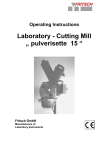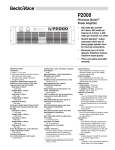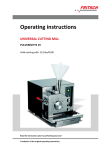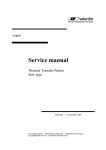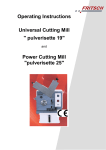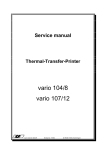Download Operating Instructions Laboratory Mortar
Transcript
Operating Instructions Laboratory Mortar Grinder „ pulverisette 2 “ Fritsch GmbH Manufacturers of Laboratory Instruments Operating Instructions, Version of December 1, 1995 (Valid from Ser.-No. 5000) Copyright 1995 (Diese Betriebsanleitung ist auch in Deutsch erhältlich) FRITSCH GmbH Telephone Manufacturers of Laboratory Instruments Fax Industriestraße 8 Telex 06784700 067847011 426203fritsd D - 55743 Idar-Oberstein Fritsch GmbH On June 24, 1995, Fritsch GmbH was certified by the TÜV-Zertifizierungsgemeinschaft e.V. An audit was conducted (Report No. Q94/107) to verify that Fritsch meets the requirements of DIN ISO 9001 / EN 29001 (Certificate No. 71 100 4 008) ________________________________________________________ Laboratory Mortar Grinder „pulverisette 2“ Page 1 Table of Contents 1 2 3 4 4.1 4.2 4.3 5 5.1 5.2 5.3 6 7 7.1 7.2 7.3 8 8.1 8.2 9 10 10.1 10.2 10.3 10.4 11 12 Page Safety Signs, Application and Use Safety Instructions Method of Operation Operating Safety Setting up Electrical Connections Checking for accordance of voltage and current Motor Fuses Front Panel Power on Activating the Laboratory Mortar Grinder Overload switch Selection of mortar bowl and pestle Installation of the grinding set Mortar bowl Pestle Scraper Grinding Charging the sample to be ground Collecting the ground sample Grinding during forced cooling Maintenance Cleaning Re-grinding the grinding set Drive motor Instrument Warranty Technical Data List of Spareparts Wiring Diagram 3 4 7 7 8 8 8 8 8 9 9 9 9 10 10 11 11 12 12 12 13 13 14 14 14 14 15 15 15 16 17 ________________________________________________________ Laboratory Mortar Grinder „pulverisette 2“ Page 2 Safety Signs Application and Use Safety signs indicate dangers: Caution: Combustible ma- Materials detriterials mental to health Danger, electrical power Caution Warning of dangers Wear eye protection Use of the Laboratory Mortar Grinder This operator’s manual describes the area of application and the use of the Laboratory Mortar Grinder. Any use other than for grinding with the grinding parts manufactured by Fritsch is impermissible Modifications may be made to the Mortar Grinder only after consultation with and written approval from FRITSCH. If modifications are made without approval, the conformity declared by FRITSCH in respect of the European directives will no longer apply. · Exercise caution when working with combustible or poisonous materials. Always comply with valid safety regulations (MAC values) when handling samples or cleaning liquids which are dangerous to your health. Where applicable, set up the Mortar Grinder in a well-ventilated safety zone. ____________________________________________________________________________ Laboratory Mortar Grinder „pulverisette 2" page 3 Safety Instructions · Do not remove information signs. · Allow only trained personnel to perform maintenance. · Replace covers after maintenance. · Do not disable safety devices permanently. · Check safety device regularly. · „Out of service“ Þ Turn off master switch on rear side. · Allow only trained specialists to work on the mill. · Do not open Laboratory Mortar Grinder until it is completely stopped. · Always wear safety glasses when working. · Operate Mortar Grinder only with fixed pestle. · Do not put your hands into Mortar Grinder while it is running. · Set up the Laboratory Mortar Grinder indoors only. · Set it up on a sturdy work table. · Ambient temperature 0 to 40°C · Dimensions: 395 x 435 x 870 mm (H x W x D) · Weight (net): approx. 30 kg · Danger: Electricity: · The instrument contains electrical switches in the low voltage range 230 Vrms. · Noise level: 70 dB · Beware of: · Squeezing on counterweight! · Squeezing on lid toggle catch ! · Squeezing on pestle fixing device and its spindle! Read instructions manual before use! ____________________________________________________________________________ Laboratory Mortar Grinder "pulverisette 2" page 4 Safety Instructions Unpacking · Attention: Weight of Laboratory Mortar Grinder = 30 Kg · Compare the content of the box with your order! 1. Pull out the staples with the help of a pincers resp. cut the closing band of the box. 2. Open the cover of the box and 3. take out the accessories such as grinding set, pestle and Plexiglas lid. 4. Don´nt use the rod as a hold. Take out the Mortar with both hands at the lid. Mounting the Plexiglas Cover 1. Remove the paper 2. Fasten the cover with 4 screws - you will find the screws at the hinges. ____________________________________________________________________________ Laboratory Mortar Grinder "pulverisette 2" page 5 Operating Instructions Laboratory Mortar - Grinder „ pulverisette 2 “ The „pulverisette 2“ is an automatic mortar grinder for the universal dry- or wet grinding down to analytical size. When preparing samples for the synthesis, the Laboratory Mortar Grinder is used for mixing or homogenising dry samples, emulsions or pastes. The Laboratory Mortar Grinder grinds inorganic as well as organic samples for the analysis, quality control and material testing as for example: Plants leafs coniferous needles spices nuts almonds food gelatine sugar grain pellets feed drugs dragèes tablets soil coal ashes chemicals fertilisers chalk clay porcelain gypsum lime clinker cement silicate cinder The initial feed size should not exceed 3 mm and the quantity of a charge should not be more than 150 ml. (Larger pieces shall be reduced to small pieces before charging into the grinder.) The final fineness will depend upon the grinding time - 1 μm as a mean particle size can be reached. _________________________________________________________ Laboratory Mortar - Grinder "pulverisette 2" Page 6 951201VB 1 Method of Operating The size reduction from dried foods with hand mortar and pestle is the oldest known grinding procedure. Archaeologists in Jordan have found a mortar with stage whose age could be determined at approx. 10.000 years. Similar to hand mortar and pestle by using the Laboratory Mortar Grinder the comminution takes place by pressure and friction between the mortar bowl and the free rotating pestle. But opposite to the hand mortar the automatic mortar is rotating and the axis of the pestle is in a stationary position. A relatively large grinding surface ensures quick and uniform process and simple pestle adjustment. Sticky materials could be ground after adding some liquid into the bowl. The sample is moved by the motor-driven mortar bowl and taken off from the wall and the bottom of the mortar bowl by the Vulcollan scraper. The sample is turned around by the scraper working like a plough bringing it back in front of the pestle. Compared to the usually more plain hand mortars the grinding bowl of the Laboratory Mortar Grinder is closed. A lip seal between grinding bowl and lid guarantees for lossfree comminution - even if suspension is to be ground. Reproducible results are obtained by the built-in timer and the easy positioning of the load of the pestle. A large acrylic safety cover permits observation of the grinding process which can be controlled by adjustment of scraper and pestle. The extremely robust construction of the driving unit, the guidance of the pestle and all the other movable parts guarantees for a long lasting lifetime of the unit and prepared it in everydays readiness. 2 Operating safety The operating safety of the Laboratory Mortar Grinder was proofed by the TÜVSaarland. After the successful final test the TÜV-Saarland certified that the Laboratory Mortar Grinder by with its construction and manufacturing meets the requirements of DIN EN 61010 (03/94) resp. IEC-1:1990+ A1:1992. This was confirmed by an official Certification of Conformity. The enclosed „Declaration of Conformity“ ensures, that the Laboratory Mortar Grinder delivered with this paper was built according to the regulations. _________________________________________________________ Laboratory Mortar - Grinder "pulverisette 2" Page 7 3 Setting up the Laboratory Mortar Grinder Set up the Laboratory Mortar Grinder indoors on a flat, sturdy surface. It is not necessary to fasten it in place. The room temperature must be between 0 and 40°C. Make certain that the grinder is easy to access. 4 Electrical connections 4.1 Checking for concordance of voltage and current Before connecting the grinder, check the setting of the voltage selector on the back of the grinder and compare it to the voltage of your local mains. Þ Only a trained specialist is permitted to change over the supply voltage and/or alter the connecting cable. The slot in the axle of the switch must point to the value of your network. 100/110/200/230/240 V A.C. with protective earth; fuse max. 16 A Turn on the master switch (black switch) on the rear side. The green lamp (Power On) will light up. 4.2 Motor The motor (single-phase brushless A.C. motor with PE conductor, 50/60Hz) can be started by turning the timer. In the case of overload - f.e. after blockage of the mortar - the drive motor is protected by an overload switch on the front panel. To continue the grinding process - after release of the blockage - press the button in the middle of the switch. 4.3 Fuses There is a fuse in the connection plug at the rear side of the grinder, above the inlet for the power cable. Replacement: 5 x 20 TA4 _________________________________________________________ Laboratory Mortar - Grinder "pulverisette 2" Page 8 5 Front Panel 5.1 Power on The green lamp (Power On) will light up after you turn on the master switch (black switch) on the rear side. 5.2 Activating the Laboratory Mortar Grinder Timer: 1. Setting the run time: Set knob-operated switch of timer to run time. 2. Setting constant operation: Set knob-operated switch of timer to continuous operation "ON". 3. Maximum grinding period: 1 hour. 4. Before restarting, examine the grinding conditions. 5. When operating with external timer, examine the temperature of the sample. Shutting down: Wait until time set on the timer has elapsed, or turn knob-operated switch on timer to "OFF". 5.3 Overload switch The motor is protected against overload - f.e. after blockage of the mortar - by an overload switch. To continue the grinding process - after release of the blockage - press the button in the middle of the switch. _________________________________________________________ Laboratory Mortar - Grinder "pulverisette 2" Page 9 6 Selection of mortar bowl and pestle When selecting the material of the grinding set you must consider the hardness of the sample and the tolerated contamination arising from the abrasion of the grinding set. Even a very small contamination may qualitatively influence your analytical results. Mortar bowl and pestle can be supplied with the following materials: Material (Mortar and pestle) Order. NR. (Complete set) Abrasion resistance 46.011.00 adequate Mineral materials Hard Porcelain Sintered Corundum 1 85% Al2O3 46.007.00 satisfactory Sintered Corundum 2 99.7% Al2O3 46.006.00 rather good Agate 99.9% SiO2 46.005.00 good Zirconium Oxide 94% ZrO2 46.012.00 very good Chrome-Nickel-Steel acidproof 46.010.00 rather good Chrome-Steel hardened 46.009.00 good 46.008.00 very good Metallic materials Tungsten Carbide 93% WC + 6% Co 7 Installation of the Grinding Set Caution: The parts of the grinding set installed in the mortar grinder have been exactly matched to each other. Therefore mortar bowl, pestle and scraper must always be used jointly. The setting of mortar bowl, pestle and scraper has been optimised at works. Depending of the hardness of the sample to be ground, the pestle and the scraper must be re-set from time to time. Also when a different grinding set (or a new one) is installed, the setting must be readjusted. _________________________________________________________ Laboratory Mortar - Grinder "pulverisette 2" Page 10 7.1 Mortar Bowl To replace a mortar bowl, simply lift the bowl from its support plate and put it back by placing it on to the support, the two traction screws being introduced in the two holes on the bottom of the plastic setting of the bowl. The bowl should not „dangle“. 7.2 Pestle To remount or replace a pestle you need the enclosed tools: · Fork wrench 19 mm, · Fork wrench 24 mm, · Hexagon socket screw key (Allan key) 3 mm and · Face spanner 1. Hold the pestle axle with the provided fork wrench 19 mm. Then loosen the counter screw with the provided fork wrench 24 mm. The pestle can than be unscrewed from the axle by turning to the left. 2. Re-mounting the pestle is being done the opposite way. When the lid is closed, the pestle must be well set in the lower radius of the mortar bowl. To enable you to do this setting the axle of the pestle is arranged eccentric. Turning this eccentric the axis will be drawn near the edge of the bowl resp. the opposite way. The eccentric is fixed with a hexagon socket screw. 1. Fill in the bowl some sample (f.e. small amount of sand). The sand will take care of the friction between bowl and pestle in order to turn around the pestle. Only by this you will be able to do the setting correctly. 2. Close the lid and fasten the locking system. 3. To frees the eccentric loosen the 3 mm hexagon socket with the Allan key. 4. Insert the provided face spanner into the eccentric and reset the eccentric in a way that the pestle slightly presses against the radius of the mortar bowl. Caution: The front of the bowl should not come up! If the setting is correctly done, then the pestle will rotate on itself by gentle pressure against the radius of the bowl. If the pestle does not rotate, than the setting must be corrected. 5. Re-tighten the 3 mm hexagon socket screw firmly. _________________________________________________________ Laboratory Mortar - Grinder "pulverisette 2" Page 11 7.3 Scraper The Vulkollan scraper can be adjusted horizontally with the spherical button and vertically by loosening and re-tightening the side knob. A new scraper has to be ground before use: · The part in contact with the bottom of the bowl must be ground so that its rear edge (in eye direction) touches the bottom. · The part of the scraper in contact with the wall must be ground so that its front edge (in eye direction) touches the bottom and the scraper wipes off the sample from the bowl. 8 Grinding Instructions: Before closing the lid, make certain that the grinding set is firmly seated. · Close lid securely. · Pay attention to heating of material to be ground: in case of longer run time, possibly stop to cool down. In order to go easy with the grinding parts: Laboratory Mortar Grinder with lid in closed position should not be operated the lid being closed without sample to be ground. 8.1 Charging the sample 1. Open the cover and the lid of the Laboratory Mortar Grinder and fill in the sample into the mortar bowl. The initial feed size should not exceed 3 mm and the quantity should not be more than 150 ml. 2. Switch-on the instrument. 3. Then close the lid. By doing this, lift the pestle by pushing up the weight on its rod. 4. After having closed the lid locking system slowly release the weight on its rod on the sample to be ground. 5. By sliding the weight on its rod, the grinding pressure on the sample can be selected and thus the load of the pestle can be adapted to the hardness and the grindability of the sample. (Front position: ca. 3 kg load, rear position: ca. 9 kg load.) 6. Then close the cover. _________________________________________________________ Laboratory Mortar - Grinder "pulverisette 2" Page 12 Advice: For preliminary crushing of larger pieces you may slowly release the pestle on the sample in order to break them before the pestle reaches its normal operating position and can be arrested. 8.2 Collecting the ground sample 1. After completion of the grinding process turn the timer in its „OFF“ position or the timer stops the unit by itself. 2. Lift the cover and lift up the rod with the grinding weight before the lid is opened. Then lift the pestle out of the bowl by opening the lid until the rod comes to a stand at the rear side. 3. Remove the bowl out of its recess by hand and collect the sample. Advice: You may collect your sample more complete by lifting the lid only a little and clean up the pestle from sticking sample f.e. using a brush. The sample will drop directly into the bowl. 9 Grinding during forced cooling Whenever material which is very heat sensitive is to be ground, we recommend a forced cooling with liquid nitrogen. The liquid nitrogen is introduced directly into the bowl together with the material to be ground. "Dry ice" (solid carbon dioxide) can also be used. Keep in mind, however, that dry ice frequently contains frozen condensation water on its surface. Caution: Wear safety glasses when working with liquid nitrogen: With some materials to be ground, grinding can be improved by using coolants prior to grinding. For example, animal tissue or special plastics can be rendered brittle by dipping them briefly in to liquid nitrogen or freezing them in a deep freeze beforehand. Here, too, you must protect the material to be ground against condensing water. For example, you could place the material in a PVC bag during the cooling procedure. _________________________________________________________ Laboratory Mortar - Grinder "pulverisette 2" Page 13 10 Maintenance The most important process in preventive maintenance is regular cleaning: Caution: The cleaning and maintenance of the Laboratory Mortar Grinder has to be done in accordance to the national safety regulations - specially when the environment contains certain amount oft dust so that dust explosion could happen. 10.1 Cleaning of the Laboratory Mortar Grinder The frequency with which a thorough cleaning must be performed depends on the grinding material and its final fineness. We recommend adapting the cleaning intervals to the use of the Laboratory Mortar Grinder by making regular checks at the outset. When the lid is open, the mortar bowl can be removed and can easily be cleaned - i.e. under running water. The pestle and the scraper are easily accessible when the lid is open and grinding residues are to be removed. Use a brush too if necessary. Residual ground material on the rubber seal at the lid or at the border of the mortar bowl may destroy the lip seal We can also recommend alcohol as an organic cleaning media. Other solvents should not be utilised. (See paragraph 7 as to dismantling the pestle and the scraper.) 10.2 Re-grinding the grinding set After a long use scratches or roughness may appear on the grinding surfaces of the grinding set. In such cases, charge about 20 gr. carborundum (silicon carbide) of 0.5 mm particle size and about 20 ml water into the bowl, close the lid and let the instrument operate for about 30 minutes to 1 hour. The silicon carbide paste in the mortar bowl will re-grind the grinding set to a great extend by abrasion. 10.3 Drive motor The drive motor does not require any maintenance. The switches installed on the grinder should be checked for function (smoothness of action) in event of contamination. 10.4 Laboratory Mortar Grinder The Laboratory Mortar Grinder itself does not require any maintenance. The bearings of the rotating components are permanently lubricated. _________________________________________________________ Laboratory Mortar - Grinder "pulverisette 2" Page 14 11 Warranty The warranty card enclosed with this shipment must be returned to the supplier completely filled out in order for the warranty to take effect. Fritsch GmbH of Idar-Oberstein and our "Application technology laboratory" and/or our agent in your country will be glad to advise and help you. In order to answer any questions you may have, we will require the serial number stamped on the nameplate. 12 Technical Dates Weight with mortar bowl and pestle: 30 kg Dimensions: H, W, D: 450, 250, 450 mm Power consumption at 22°C and 225 Volt: I = 0.87 A Power P = 145 W max. Power Pmax = 165 W _________________________________________________________ Laboratory Mortar - Grinder "pulverisette 2" Page 15



















